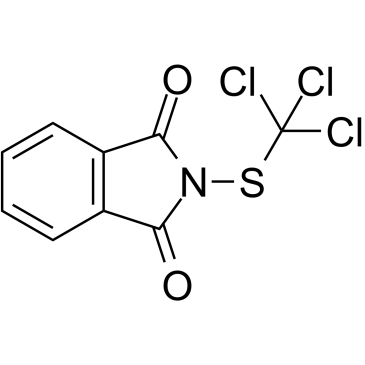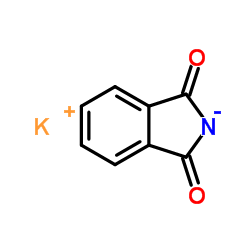Folpet

Folpet structure
|
Common Name | Folpet | ||
|---|---|---|---|---|
| CAS Number | 133-07-3 | Molecular Weight | 296.56 | |
| Density | 1.7±0.1 g/cm3 | Boiling Point | 333.8±52.0 °C at 760 mmHg | |
| Molecular Formula | C9H4Cl3NO2S | Melting Point | 177-180°C | |
| MSDS | Chinese USA | Flash Point | 155.7±30.7 °C | |
| Symbol |



GHS07, GHS08, GHS09 |
Signal Word | Warning | |
Use of FolpetFaltan is a dicarboximide fungicide, widely used on vines and several vegetable crops, and is also cytotoxic effect on human bronchial epithelial cells[1]. |
| Name | folpet |
|---|---|
| Synonym | More Synonyms |
| Description | Faltan is a dicarboximide fungicide, widely used on vines and several vegetable crops, and is also cytotoxic effect on human bronchial epithelial cells[1]. |
|---|---|
| Related Catalog | |
| References |
| Density | 1.7±0.1 g/cm3 |
|---|---|
| Boiling Point | 333.8±52.0 °C at 760 mmHg |
| Melting Point | 177-180°C |
| Molecular Formula | C9H4Cl3NO2S |
| Molecular Weight | 296.56 |
| Flash Point | 155.7±30.7 °C |
| Exact Mass | 294.902832 |
| PSA | 62.68000 |
| LogP | 2.85 |
| Vapour Pressure | 0.0±0.7 mmHg at 25°C |
| Index of Refraction | 1.693 |
| InChIKey | HKIOYBQGHSTUDB-UHFFFAOYSA-N |
| SMILES | O=C1c2ccccc2C(=O)N1SC(Cl)(Cl)Cl |
| Water Solubility | practically insoluble |
CHEMICAL IDENTIFICATION
HEALTH HAZARD DATAACUTE TOXICITY DATA
MUTATION DATA
|
| Symbol |



GHS07, GHS08, GHS09 |
|---|---|
| Signal Word | Warning |
| Hazard Statements | H317-H319-H332-H351-H400 |
| Precautionary Statements | P261-P273-P280-P304 + P340 + P312-P333 + P313-P337 + P313 |
| Personal Protective Equipment | Eyeshields;Faceshields;full-face particle respirator type N100 (US);Gloves;respirator cartridge type N100 (US);type P1 (EN143) respirator filter;type P3 (EN 143) respirator cartridges |
| Hazard Codes | Xn,N |
| Risk Phrases | R20 |
| Safety Phrases | S36/37-S46-S61 |
| RIDADR | UN 3077 9/PG 3 |
| RTECS | TI5685000 |
| HS Code | 2930909057 |
|
~% 
Folpet CAS#:133-07-3 |
| Literature: Science (Washington, DC, United States), , vol. 115, p. 84 US2553770 , ; US2553771 , ; |
|
~% 
Folpet CAS#:133-07-3 |
| Literature: Naturwissenschaften, , vol. 44, p. 517 US2553776 , ; |
|
~% 
Folpet CAS#:133-07-3 |
| Literature: Acta Crystallographica Section C: Crystal Structure Communications, , vol. 56, # 1 p. 97 - 98 |
| Precursor 2 | |
|---|---|
| DownStream 0 | |
| HS Code | 2930909057 |
|---|---|
| Summary | 2930909057 2-((trichloromethyl)thio)-3a,4,7,7a-tetrahydro-1h-isoindole-1,3(2h)-dione。supervision conditions:s(import or export registration certificate for pesticides)。VAT:17.0%。tax rebate rate:9.0%。MFN tarrif:6.5%。general tariff:30.0% |
|
Toxicokinetics of captan and folpet biomarkers in orally exposed volunteers.
J. Appl. Toxicol. 32(3) , 194-201, (2012) The time courses of key biomarkers of exposure to captan and folpet was assessed in accessible biological matrices of orally exposed volunteers. Ten volunteers ingested 1 mg kg(-1) body weight of cap... |
|
|
Air pollutants formed in thermal decomposition of folpet fungicide under oxidative conditions.
Environ. Sci. Technol. 45(2) , 554-60, (2011) This contribution studies the decomposition of folpet fungicide under oxidative conditions and compares the product species with those of captan fungicide, which is structurally related to folpet. Tox... |
|
|
Liquid chromatography-tandem mass spectrometry (LC/APCI-MS/MS) methods for the quantification of captan and folpet phthalimide metabolites in human plasma and urine.
Anal. Bioanal. Chem 399(6) , 2243-55, (2011) Captan and folpet are fungicides largely used in agriculture. They have similar chemical structures, except that folpet has an aromatic ring unlike captan. Their half-lives in blood are very short, gi... |
| Ftalan |
| N-trichloromethylsulfanyl-phthalimide |
| N-(trichloromethylthio)phthalimide |
| Faltan |
| Phthalimide, N-[(trichloromethyl)thio]- |
| EINECS 205-088-6 |
| 1H-Isoindole-1,3(2H)-dione, 2-[(trichloromethyl)thio]- |
| 2-[(trichloromethyl)thio]-1H-isoindole-1,3(2H)-dione |
| 2-(Trichloromethylsulfanyl)isoindole-1,3-dione |
| Spolacid |
| n-(trichloromethylmercapto)phthalimide |
| Folnit |
| Folpel |
| Folpan |
| PHALTAN |
| Orthophaltan |
| 2-[(Trichloromethyl)sulfanyl]-1H-isoindole-1,3(2H)-dione |
| Phthaltan |
| N-(trichloromethanesulfenyl)phthalimide |
| 2-((Trichloromethyl)thio)isoindoline-1,3-dione |
| MFCD00047303 |
| Folpet |




